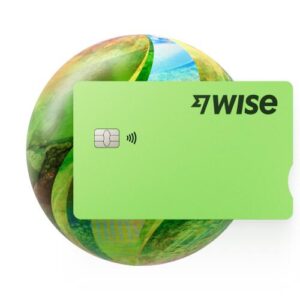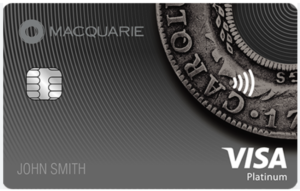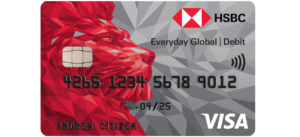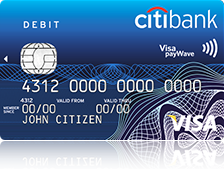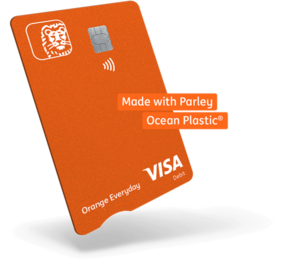5 Best Debit Cards for Australians Travelling Overseas - 2025
Here is a list of the 5 best travel debit cards you can take with you on your travels and the positives and negatives for each one:
- Wise - our pick for travel debit cards
- Revolut - low fees
- HSBC - good for cashback
- Macquarie Platinum - no bank withdrawal fees
- ING Orange Everyday - cash back option
Wise - our pick for travel debit card for international travel
- No annual fee, hidden transaction fees, exchange rate markups
- No minimum balance requirements
- Allows you to make payments and withdrawals wherever you are in the world in over 40 currencies
- Local bank account details in Australia (AUD), the UK (GBP), the USA (USD), Europe (EUR), Canada (CAD) and New Zealand (NZD)
- Available in the US, UK, Europe, Australia, Singapore, Japan and New Zealand
Find out more about the Wise card.
More about the Wise card
With this card:
- It's very easy to set up and order
- You can receive foreign currency into a multi-currency account linked to the card
- Pay with your Wise card in most places overseas where debit cards are accepted
- You can transfer money to a bank account overseas
- Currency conversion using the mid-market exchange rate
It's not all good news though
- There is a 2% ATM withdrawal fee when you withdraw over $350 during a month
- It takes 7-14 days for delivery
Go to Wise or read our review.
Revolut - low fees
- Very easy to use app
- Free to set up
- No hidden fees or exchange rate mark-ups (except on weekends)
- You can use it to transfer money to a bank account overseas
More about the Revolut card
With this card:
- No purchase fee, load fee, reload fee, exchange rate margin or minimum balance requirements
- Unlike other Travel Cards, its free and easy to use the balance of your currency or convert it back to AUD
- The exchange rates are unbeatable. They use the same rate you see on XE or Google with no hidden mark-up
It's not all good news though
- For the free Standard account, there is a 2% ATM withdrawal fee when you withdraw over $350 during a month
- The premium account costs $10.99 a month, which can really add up if you are not using it often
- Additional fees for using the card on a weekend
- 2% ATM fee once you withdraw more than $350 in any 30 day period
- 3-4 business days before you receive your card
Click here to see the full list of cards and how Revolut compares
Macquarie Platinum Transaction Account
- Day to day transaction account, which comes with a linked Platinum Debit Mastercard
- No annual fee and no foreign transaction fee to pay when spending
- Macquarie doesn’t charge ATM fees, and will rebate fees charged by ATM operators in Australia
- Available to Australian residents - business accounts are not available
More about the Macquarie Platinum card
With this card you can:
- Spend globally with your debit card, with no foreign transaction fee
- Make withdrawals internationally with no Macquarie fee to pay
- Earn variable interest rates based on your account balance
- Send payments to others locally directly from your account
It's not all good news though
- International ATM fees may be applied by the ATM operator
- If you want to send money overseas you’ll need to register with a third party provider
- Interest rates are variable and get lower for higher balance amounts
- No foreign currency holding or exchange option
The HSBC Everyday Global Debit Card - good for cash back
- Earn up to $50/month cash back on eligible tap and pay purchases
- No monthly fees and no HSBC transaction fees
- Easy to use everyday account for a range of foreign currencies
- No foreign transaction fees applied
More about the HSBC card
With this card you can:
- Buy, hold and spend in 10 currencies
- Earn up to $50/month cash back
- Make ATM withdrawals overseas with no HSBC charges
- Spend on the go using Visa payWave, Google Pay and Apple Pay
- Exchange between currencies in your account instantly with the HSBC banking app
It’s not all good news though:
- Currency exchange may incur a fee in the form of a marked up exchange rate
- Not the broadest range of currencies available
- Eligibility restrictions may apply to unlock some features - you’ll have to deposit your salary to the account to get cash back
- $8 international transfer fee can work out quite steep for lower value payments
- You’ll need to deposit at least $2,000 a month to get cash back
- Limitations apply to the ways you can use CNY currency within the account
Citibank Saver Plus - not available anymore
- No international ATM or transaction fees
- Fee-free international money transfers to any account worldwide
- SMS notifications through Citi Alert
More about the Citibank card
With this card you can:
- withdraw money for free at over 3000 ATMs Australia-wide and overseas
- take advantage of no foreign transaction fees, monthly fees, or minimum opening balance
- transfer money to friends and family anywhere in the world for free
It's not all good news though
- Cash deposits available within 24-48 hours
- Can’t have two cards active at the same time
- $5 account closure
ING Orange Everyday - earn interest
- Everyday transaction account with linked Visa debit card
- No annual fee and no maintenance fee
- Deposit 1,000 AUD a month, or complete 5 transactions monthly with your card to have foreign transaction fees waived
- Earn interest on your account balance
- Available to Australian tax residents, with a valid Australian phone number and email
More about the ING Orange card
With this card:
-
- Spend with no foreign transaction fee as long as you meet eligibility criteria
- Qualify for some local ATM rebates
- Get 1% cash back, to an annual maximum of 100 AUD on your utility spending
- Earn interest on your account balance
It's not all good news though
-
-
- You’ll need to deposit 1,000 AUD a month, or meet other eligibility criteria to access full benefits
- 5 AUD international ATM fee
- Only 5 domestic ATM withdrawals qualify for fee rebates - eligibility criteria apply
- 3% foreign transaction fee if you don’t hit eligibility criteria to have the fee waived
- No multi-currency holding or exchange options
-
What are Travel Debit Cards?
As Australians, we love to travel. Almost 10 million of us took to the skies last year, mostly to our neighbours in New Zealand and Indonesia, but also further away to the US and Europe.
While we travel, we also need safe access to cash. It's not the most glamorous part of our travel plans, but it's equally important to decide on the best travel money option for us, so we're not left worried at any stage of our trip.

Travel debit cards are a good alternative to carrying cash. They also offer the convenience of a credit card, but work differently.
When you use your debit card overseas, you're drawing money directly from your bank account when you make a purchase. It's designed for everyday money transactions and means you're not accumulating debt.
Debit cards are a great option if you've saved money specially for your trip and if you want to budget your overseas spending. Some debit card providers offer virtual cards, which allow you to spend on your phone while you travel and stay protected from fraud.
We also suggest bringing a back-up debit card and a separate credit card for peace of mind and greater flexibility on your trip.
Pros and cons of travel debit cards
For many people, holding a specific travel debit card alongside one or more regular credit or debit cards can make spending on holiday easier and cheaper. With multi-currency accounts you’ll be able to top up in dollars and switch to the currency you need online or via an app. That gives you total control of your budget and lets you see exactly how much you have available for spending at any one time.
- No monthly fees and no HSBC transaction fees
- Easy to use everyday account for a range of foreign currencies
- No foreign transaction fees applied
- $8 international transfer fee can work out quite steep for lower value payments
- Currency exchange may include a margin or markup
- You’ll need to deposit at least $2,000 a month to get cash back
- Limitations apply to the ways you can use CNY currency within the account
Should you use a debit card for overseas travel?
Spending with a card when you travel overseas can be a very convenient option. It also means you don’t need to carry a lot of cash with you - which can be safer too.
Choosing a debit card over a credit card might mean you pay fewer fees when you’re overseas, as you’ll avoid cash advance charges and interest costs. However, you may find your debit card has its own charges which you’ll need to know about before you get started. Look out in particular for foreign transaction fees which are often around 3%, and are added every time you make a purchase or withdrawal in a foreign currency.
Which is the best debit card for overseas travel?
There’s no single best travel debit card. However, there are a few important things to look out for when you’re picking the right debit card for your trip.
Firstly, it’s worth picking a card on a popular global payment network like Visa or Mastercard. These networks are accepted in most countries around the world, so it’s likely you’ll be able to use them wherever you’re headed.
Secondly, check your card’s foreign transaction fees. This charge is often a percentage added to every dollar you spend or withdraw in a foreign currency. It may not look like a large amount - often around 3% or so - but it can quickly mount up when you’re away from home.
And finally, one last check - take a look at the fees your bank will charge you for overseas ATM withdrawals. Some accounts from providers like Wise and Revolut have low or no fees for overseas withdrawals - but others can crank up the costs so using your card abroad is far more expensive than using it at home.
Which international debit card has no fees?
Some providers offer travel debit cards with no foreign transaction fees, although it’s often impossible to completely avoid extra costs when you’re spending in foreign currencies. To get the best available deal you might want to pick a card with no foreign transaction fee such as the Wise card, the Revolut card, or the Macquarie Platinum Mastercard.
Providers like Wise and Revolut, which offer multi-currency account options, can also be handy as you’ll be able to switch your dollars to the currency you need before you travel if you’d like to, so you can see exactly what your budget is in the local currency wherever you’re headed. Then just link the travel debit card they provide and spend as normal with it, with no foreign transaction fee to worry about.
What is the difference between travel debit cards and credit cards?
Travel debit cards and credit cards work in different ways - which might make them better suited to specific customer needs. With a credit card you can spread the costs of your spending over a few months - but you’ll need to pay interest if you choose to do this, pushing up the cost overall. Credit cards optimised for travel may also offer rewards, cash back or benefits such as free airport lounge access, but there may be an annual fee to pay to get these perks.
With a travel debit card you’ll need to have the funds in your account already before you head off - but in return, the overall costs may be a little lower. Travel debit cards from specialist services like Wise and Revolut are also handy as they are attached to multi-currency holding accounts you can use to keep your funds in a foreign currency conveniently. That can ultimately mean you save money, and can access better exchange rates compared to using your normal bank.
FAQ on best debit cards for overseas travel
What is a travel debit card?
A travel debit card is intended to make travel spending more convenient and often cheaper. You’ll be able to add funds to your account in AUD and switch to different currencies supported by your travel debit card, to spend when you travel more easily.
How to choose a debit card for overseas travel?
Before you decide which travel debit card suits you, think about how you’ll use the card, and compare the features and fees on offer from different providers. Picking a card with no ongoing fees and no minimum balance will be important if you don’t expect to travel so frequently. However, upgrading to a card which comes with a monthly fee might be worthwhile if the fees unlock features you value. Take your time to decide - the perfect travel debit card for you is out there somewhere.
Which debit card is best for travel?
The right travel debit card for you depends on your specific needs and preferences. Some cards offer a really broad range of currencies with easy, low fee conversion. Others have travel friendly perks like free insurance or cash back. By considering the types of transactions you’ll make, and comparing a few options like those picked out above, you’ll be able to find the best travel debit card for your needs.
How do I make my debit card international?
Debit cards issued on major payment networks like Visa and Mastercard are accepted internationally. Your own bank might require you to inform them of your travel plans, so that payments made overseas don’t flag as suspicious on their anti-fraud monitoring. Double check with your card issuer to see if there’s any need to notify them of your travel plans - and don’t forget to also look out for the foreign transaction fees applied to overseas spending, to check you’re not charged more to use your card overseas. If you are, you may be better off with a specialist card from a provider like Wise or Revolut.
What is the best way to pay when travelling abroad?
Carrying cash when you travel isn’t always convenient - and it can also be risky. For many people, paying for their travel with a small amount of cash, backed up with a good travel debit card and one or two additional credit or debit cards can work well. Use your cards to make payments and withdrawals whenever you need to, with the knowledge you can instantly cancel or freeze the card if you’re ever concerned about their security.


